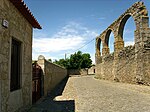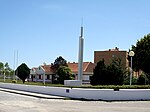Monastery of Santa Clara

Monastery of Santa Clara or Convent of Santa Clara in Vila do Conde, Portugal was one of the biggest and richest feminine convents in Portugal, founded in 1318, by Afonso Sanches and his wife, Teresa Martins Telo.The large historical complex includes the Gothic Santa Clara Church (1318), nearby Manueline late Gothic constructions and the current proper monastery, built in the early phase of the neoclassical style in 1777. The Monastery is located in a hilltop and includes large walls that protect the monastery from the east and the Santa Clara Aqueduct, the second largest aqueduct in Portugal. The monastery is considered a fundamental temple of the Portuguese Gothic architecture North of Douro river.
Excerpt from the Wikipedia article Monastery of Santa Clara (License: CC BY-SA 3.0, Authors, Images).Monastery of Santa Clara
Avenida José Régio, Vila do Conde
Geographical coordinates (GPS) Address Website External links Nearby Places Show on map
Geographical coordinates (GPS)
| Latitude | Longitude |
|---|---|
| N 41.3525 ° | E -8.7391666666667 ° |
Address
Mosteiro de Santa Clara (Mosteiro de Santa Clara de Vila do Conde;Reformatório de Vila do Conde;Centro Educativo de Santa Clara)
Avenida José Régio
4480-791 Vila do Conde (Vila do Conde)
Portugal
Open on Google Maps








